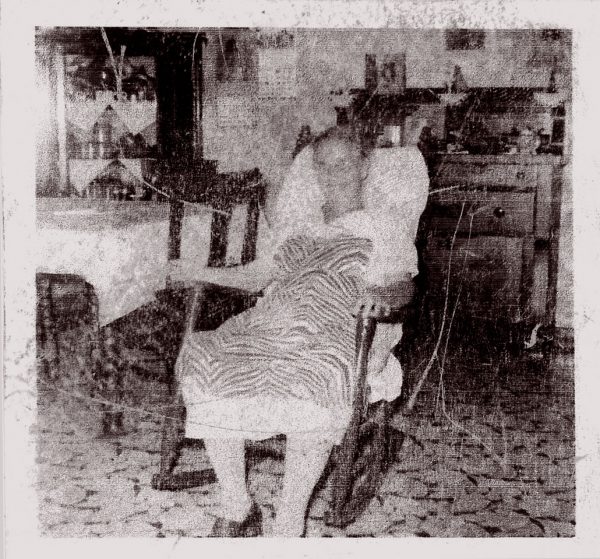Heirlooms as Memory
Kayla O’Daniel
Discovering the Past
“Take a drive down memory lane.” The expression was particularly poignant, as I drove to my grandparents’ house and saw it peek through the changing colors of the autumn leaves. After the recent loss of my grandfather, the time had come to sort through the piles of things my grandparents had collected over the years in the flea market business. When you come from a family that works in this industry, you either see everything under the guise of “one man’s trash is another man’s treasure” or as leftover junk that no one really wants. Due to my aversion to clutter, I’ve always found myself positioned toward the latter—but that day was different.
I followed my mother to the larger of the two double-wide buildings that are home to forgotten treasures of the past—the decrepit wood and tin building alluding to the wonders inside. As my mother walked up to unlock the padlocked doors, practically falling off the hinges, I feared that these objects would evoke emotions of my grandfather.
The space was filled to the brim with oddities, leaving only a narrow passageway for us to walk through. Everything seemed to carry a different, weightier meaning. These objects, which had lost most of their function, were waiting to be claimed by an unknown future owner, or they were waiting to meet their ultimate resting place among the piles of forgotten and discarded things in landfills.
When we made our way to the back of the building, we found an old rocking chair that had clearly seen better days. (Fig. 1) It started to rock back and forth as the midday light caressed the curves and revealed intricate details of its craftsmanship. I ran my fingers across the back of the fractured wooden headrest. The wood was scuffed, scratched, and cracking. The simple cutout detail on the backrest gave the chair a welcoming character, as if inviting you to take a load off, while the rusted nails and screws poking their way out of the seams warned you of its unsteadiness.

Figure 1. Granny Puckett and her rocking chair. Sanger, West Virginia, 1955. Photograph by Hazel Puckett. Courtesy of the Puckett family.
“That was your great-great grandmother’s chair,” my grandmother said. Over the years, I have heard many stories about my family. My great-great grandmother, Granny Puckett, often comes up in these stories—some specifically connected to this rocking chair that I had only just discovered.
I gently pushed the back of the chair, allowing the arched legs to re-familiarize themselves with this forgotten motion. Granny Puckett filled the chair as I watched it sway. She was sitting there, rocking as she glanced out from the front porch of the house at the top of the steep hill, taking in the bustling coal-mining town of Mount Hope, West Virginia. The chair was stable, reliable, and familiar, following wherever her and her coal miner husband went—or, perhaps more accurately, wherever the coal led them. She could hear her grandchildren’s laughter echoing through the wind that breezed up the hill and made the chair rock. The rocking chair remains a real piece of those stories that I had previously only heard about.
When Function is Lost
What is the use of a broken-down rocking chair? From a distance, you perceive it as a rocking chair, but as you get closer, the perception fades as reality shows you it cannot support a tired human looking for a place to rest. Does the chair lose all meaning if it does not function properly in relation to the world?
If we rid ourselves from presuppositions and encounter it as the thing itself, how is the chair perceived?1 With the functionality detached, it stands as only rotting wood once shaped in a meaningful way. The issue here is that we would need to disengage ourselves from the concept of a chair as something to sit on. Martin Heidegger writes, “It is language that tells us about the nature of a thing, provided that we respect language’s own nature.”2
The chair is a thing. We encounter it, touch it, relate to it and its purpose in the world. This moment of encounter with the chair fully engages us through our embodied consciousness.3 Thus, what we presume is that the chair has thingness as something to be sat on. Thingness, in this instance, is the essence for which the object exists. Heidegger writes of the jug whose thingness is embedded in the void it contains.4 Since the thingness is the void itself, the natural function that follows is to be filled. But things are contingent on their functions. If a jug is broken and no longer has the ability to contain the void, does the jug lose its meaning? As for Granny Puckett’s rocking chair, it is still a chair, even though you cannot sit in it, but this is because we are seeing wood shaped as a chair and unintentionally referring to the preconceived notion of its essence.
Perception is a quirky concept when talking about the mind’s relation to things. How does a thing gain meaning for us to assume its function? William James considers this through the lens of thoroughgoing dualism.5 There are two elements to assume toward cognition: mind knowing and thing knowing.6 The thing has a relation to the mind that provokes recognition, James writes.
Some sort of signal must be given by the thing to the mind’s brain, or the knowing will not occur—we find as a matter of fact that the mere existence of a thing outside the brain is not a sufficient cause for our knowing it…the knowledge is constituted by a new construction that occurs altogether in the mind. The thing remains the same whether known or not.7
We know the chair by a variety of means, such as its form, materials, and learned cultural meanings. The mere fact that it was once a chair still brings meaning to the deteriorating object that sits in front of me now. While the chair may have lost its thingness, as Heidegger describes, the chair still has meaning past it being lost.8
The meaning and knowledge of the chair extend past the form and change with whoever encounters it at a given state. Annelou van Gijn, professor of Archaeological Material Culture and Artefact Studies at Universiteit Leiden, and Karsten Wentink, Archaeology graduate at Universiteit Leiden, together write, “Like human beings, objects go through different stages of life and are attributed different meanings, functions, and statuses as they pass from one stage to another.”9 While van Gijn and Wentink are focusing on gaining meaning through the anthropological history of the object, let us consider this idea in relation to our individual knowledge of the rocking chair.
Rolf Haubl, sociologist and psychoanalyst, insists that the role of objects is to carry memories.10 The real meaning of the thing then is within its mnemonic value. In a way, the chair becomes a sort of transformational object, gaining more significance after the passing of its owner. Granny Puckett’s essence and memory have been absorbed into it, especially for those left in her wake, who recognize the chair as an experience of remembrance.
We depend on the chair to bring back memories of Granny Puckett. Those who knew or heard stories of her experience the chair in different ways that deepen our connection to her. These stories create a history around the object, signifying the biography of the object itself, which “is no longer simply a dead or inanimate thing,”11 as Clive Dilnot proposes. “It possesses—or we attribute to it in our imaginations—sentience and power.”12
Biographies of Objects
I encourage you to think of Granny Puckett’s chair as a subject—one that carries power past its use value, which is why heirloom owners try to understand their history. By their nature, heirlooms tend to carry extra significance. The chair as a family heirloom is now a device that conjures memory and connection across time.
Categorized as inalienable objects, as opposed to alienable objects that can disassociate from their possessors, heirlooms absorb the essence of the previous owner.13 In the instance of the rocking chair, the essence that is absorbed is Granny Puckett’s. Roberta Gilchrist cites Annette Weiner’s study of Polynesia, stating that, “Heirlooms as inalienable objects epitomize ‘the paradox of keeping-while-giving.’”14 While heirlooms are passed down through generations, they retain the memory and marks of the giver. For me, this chair signals a strong connection to family which I do not get to see often. For my grandmother, this chair represents a time when Granny Puckett lived in the house at the top of the hill in Mount Hope. For my cousin Cindy, this chair illuminates the memory of a “Rock-A-Thon,” when she rocked in Granny’s chair to raise money for her high school majorettes’ uniforms. My aunts and uncles reminisce about Granny Puckett and how she loved that rocking chair, but unlike my great-great grandfather who never let anyone sit in his chair, Granny Puckett always let her grandchildren enjoy the soothing motion of its rocking.
Heirlooms cannot be understood solely at face value. In the book, Mobility, Meaning, and Transformations of Things, Hans Peter Hahn and Hadas Weiss suggest looking at the biographies of objects in order to ascertain their value.15 These biographies illuminate ways of meaning to the surrounding environment. The rocking chair was once practical. Now, with its fractured wood, rusted nails, and dangling armrest, it serves as nothing more than an ornament seen in this light.
But as Chris Gosden and Yvonne Marshall note, “At the heart of the notion of biography are questions about the links between people and things: about the way meanings and values are accumulated and transformed.”16 Jody Joy alludes to this in the essay “Reinvigorating Object Biography: Reproducing the Drama of Object Lives”:
The biography of an object should not be restricted to an historical reconstruction of its birth, life and death. Biography is relational and an object biography is comprised of the sum of the relationships that constitute it.17
The biography of the chair no longer stops at Granny Puckett. It is now as much a biography of my grandmother, cousin Cindy, and myself—entangled in the histories of the people who encounter it.18 For this seemingly simple reason, objects—and by extension heirlooms—cannot be taken at face value, regarded for only their production, use, and demise. The heirloom is an uncanny object, taking its revenge on us by confusing us of its function and becoming, as Dilnot claims, the “impossible thing,” the object which has endowed itself with some attributes of its subjects.19
The question arises, what makes these specific heirlooms objects of memory? Hahn and Weiss cite Janet Hoskins and her book, Biographical Objects: How Things Tell the Stories of People’s Lives, insisting that “objects can be charged with meaning within quite brief moments if they are present in specific contexts of an individual’s or a family’s life.”20 Granny Puckett’s chair is charged with memories after her passing. Because of these memories, the heirloom in question is not just a chair, but also a device of reflection—illuminating the past, present, and future. This process reveals how heirlooms become objects of memory, extending past function and becoming subjects in our collective history.
1 Peter Willis, “The ‘Things Themselves’ in Phenomenology,” Indo-Pacific Journal of Phenomenology 1 (2001).↵
2 Martin Heidegger and Albert Hofstadter, Poetry, Language, Thought (New York: Perennial Library, 1975), 144.↵
3 Clive Dilnot, “Bodies: Sometimes in Pain, Sometimes Not,” I-D/International Design (1992).↵
4 Heidegger and Hofstadter, Poetry, Language, Thought, 165-182.↵
5 William James, The Principles of Psychology, vol. 1 (Cambridge, Massachusetts: Harvard University Press, 1981), 214.↵
6 Ibid.↵
7 Ibid.↵
8 Heidegger and Hofstadter, Poetry, Language, Thought, 165-182.↵
9 Annelou van Gijn and Karsten Wentink, “The Role of Flint in Mediating Identities: The Microscopic Evidence,” in Mobility, Meaning & Transformations of Things, ed. Hans Peter Hahn and Hadas Weiss (Oxford: Oxbow, 2013), 120.↵
10 Ibid.↵
11 Clive Dilnot, “The Psychoanalysis of Things,” I-D/International Design (1992).↵
12 Ibid.↵
13 Roberta Gilchrist, “The Materiality of Medieval Heirlooms: From Biographical to Sacred Objects,” in Mobility, Meaning & Transformations of Things, ed. Hans Peter Hahn and Hadas Weiss (Oxford: Oxbow, 2013), 170.↵
14 Ibid.↵
15 Hans Peter Hahn and Hadas Weiss, “Introduction: Biographies, Travels, and Itineraries of Things,” in Mobility, Meaning & Transformations of Things, ed. Hans Peter Hahn and Hadas Weiss (Oxford: Oxbow, 2013), 2.↵
16 Chris Gosden and Yvonne Marshall, “The Cultural Biography of Objects” World Archaeology 31:2 (1999), 172.↵
17 Jody Joy, “Reinvigorating Object Biography: Reproducing the Drama of Object Lives,”World Archaeology 41 (2009), 552.↵
18 Janet Hoskins, Biographical Objects: How Things Tell the Stories of People’s Lives (New York: Routledge, 1998).↵
19 Dilnot, “Psychoanalysis.”↵
20 Hahn and Weiss, “Introduction: Biographies, Travels, and Itineraries of Things,” 2.↵
Author Affiliations
Kayla O’Daniel
MA student, Design Studies, Parsons School of Design

 DESIGN STUDIES BLOG
DESIGN STUDIES BLOG

